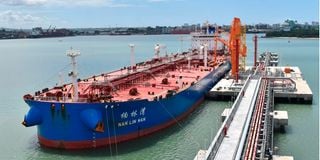How to improve the efficiency of Mombasa Port against its peers

Crude Oil Tanker 'Nan Lin Wan' discharges petroleum products at the KOT 2 in Mombasa on May 11, 2023.
According to the latest issue of the “Container Port Performance Index”, a global World Bank barometer that ranks ports based on their efficiency levels, the Port of Mombasa is underperforming.
The Mombasa port attained position 326 in last year’s edition of the ranking, compared to 296 in 2021.
While the 2022 performance was poor, of special note is the fact that the port trailed its peers in the neighbourhood with Tanzania’s Dar es Salaam, which has been touted as its biggest competitor, appearing on the list at 312th, an improvement from position 361, its locus in the 2021 edition.
To the north, and emblematic of either Mombasa’s general decline or the fast improvement of some of its competitors, Kenya’s main port was also eclipsed by the much smaller ports of Djibouti and Berbera, which rounded off the region’s performance at 26th and 144th, respectively, among a global roll of 348 ports assessed.
The ranking defines efficiency as the “elapsed time between when a ship reaches a port to its departure from the berth, having completed the process of cargo exchange”. This basically translates to the efficiency of on-ground handling services.
In a commentary accompanying the index, the World Bank opines that port performance is a key driver of economic development. The Bretton Woods Institution also states that the performance of ports has improved significantly since 2020, when the marine industry received a major hit from the general economic slowdown occasioned by the Covid-19 pandemic.
According to the Kenya National Bureau of Statistics, the volume of cargo handled by the Mombasa port fell last year—for the first time in five years—with players blaming the situation on the threat posed by an ascendant Dar in the raging trade route competition.
Cargo throughput was down to 33.74 metric tonnes (MT), against 34.92 MT in 2021. While this represents a marginal 2.93 per cent drop year on year, it is the lowest level since 2018, when Mombasa handled 30.92 MT of freight.
The poor ranking for Mombasa comes at a time when there is an inventory of infrastructure developments—completed and planned—both at the port and the hinterland, which will go a long way in improving its overall efficiency. Even then, if there is one thing the ranking proves, it is that good, modern infrastructure, while important, is not enough to underwrite port efficiency. Other factors come into play.
Second Container Terminal
There is the new Second Container Terminal, built through Japanese support. Plans by Uganda to build its leg of the standard gauge railway (SGR) from Malaba to Kampala from August, after securing a commercial bank loan and procuring a Turkish contractor, will have two net effects.
One is improving transport efficiency in Mombasa’s hinterland. The second is potentially the volume of goods handled by the port to and from a vast Northern Corridor that includes Uganda, Rwanda, Burundi and eastern DR Congo.
Goods destined for Uganda have to be transferred from the SGR to the old and slower meter gauge railway at Naivasha, inviting more bureaucracy and delays on the route. A seamless SGR line from Mombasa to Kampala would cure this.
Reports that Kenya plans to spend Sh2.1 trillion on extending the SGR line to Kisumu, Malaba and Isiolo is a potential game changer for Mombasa. Besides improving transport efficiency in the hinterland, it will expand the port’s catchment area into parts of Ethiopia and South Sudan.
This will be achieved through two feeder lines—Isiolo to Moyale on the border with Ethiopia and Isiolo to Nakodok, a border town between Kenya and South Sudan.
Besides transport in the hinterland, port efficiency must be a cooperative effort between the management of the port (Kenya Ports Authority), private sector players and the state agencies and regulators that operate from there.
The agencies include Kenya Maritime Authority, Kenya Railways Corporation, Kenya Bureau of Standards, Kenya Revenue Authority and Kenya Trade Network Agency, among others. A deliberate effort to improve port efficiency must involve all these players.
The Mombasa Port and Northern Corridor Community Charter, a 2014 initiative through which all the players undertook to play their role towards port efficiency, supported with clear service level agreements (SLAs), is a great blueprint that should be strictly enforced.
Mr Akumu is a strategic communication consultant. [email protected].




